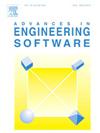集成自定义本构模型到FEniCSx:一个通用的方法和案例研究
IF 5.7
2区 工程技术
Q2 COMPUTER SCIENCE, INTERDISCIPLINARY APPLICATIONS
引用次数: 0
摘要
使用标准化接口将用户定义的构成关系开发并集成到有限元(FE)工具中,对于提高有限元求解器在结构力学应用中的能力具有举足轻重的作用。Abaqus 和 Ansys 等商业有限元求解器设计的接口可提供自定义应力、切线和更新的历史变量,而开源求解器 FEniCSx 只有在构成更新具有分析表示时才能保持高效。这限制了 FEniCSx 在非线性结构力学中的应用。由于 FEniCSx 已成为一款功能强大且广受欢迎的开源偏微分方程求解工具,特别是由于它能自动计算赫赛因,我们的目标是开发一个通用接口,以增强其在构造建模方面的能力。这种方法将解决需要在正交点水平上进行迭代求解的复杂构造方程。具体的实施挑战,如使用返回映射程序,则可以共同管理。为自定义构造模型提供的接口提供了一种通用方法,可以用各种语言(包括 C++、Python、Rust 和 Fortran)实现这些模型。最后,我们以粘弹性模型的 UMATs 为例,演示了如何将现有的用户子程序纳入界面并在 FEniCSx 框架中加以利用。本文章由计算机程序翻译,如有差异,请以英文原文为准。
Integrating custom constitutive models into FEniCSx: A versatile approach and case studies
The development and integration of user-defined constitutive relationships into finite element (FE) tools using standardized interfaces play a pivotal role in advancing the capabilities of FE solvers for structural mechanics applications. While commercial FE solvers like Abaqus and Ansys have designed their interfaces to provide custom stresses, tangents, and updated history variables, the open-source solver FEniCSx remains efficient only when the constitutive update has an analytical representation. This restricts the application of FEniCSx for non-linear structural mechanics.
Since FEniCSx has become a powerful and popular open-source tool for solving partial differential equations, particularly due to its automatic computation of Hessians, we aim to develop a generalized interface to enhance its capability for constitutive modeling. This approach will address complex constitutive equations that require iterative solutions at the quadrature point level. Specific implementation challenges, such as using return-mapping procedures, can then be managed commonly. The provided interface for custom constitutive models offers a versatile way to implement them in various languages, including C++, Python, Rust, and Fortran. Finally, with UMATs for viscoplastic models as an example, we demonstrate how existing user subroutines can be incorporated into the interface and utilized within the FEniCSx framework.
求助全文
通过发布文献求助,成功后即可免费获取论文全文。
去求助
来源期刊

Advances in Engineering Software
工程技术-计算机:跨学科应用
CiteScore
7.70
自引率
4.20%
发文量
169
审稿时长
37 days
期刊介绍:
The objective of this journal is to communicate recent and projected advances in computer-based engineering techniques. The fields covered include mechanical, aerospace, civil and environmental engineering, with an emphasis on research and development leading to practical problem-solving.
The scope of the journal includes:
• Innovative computational strategies and numerical algorithms for large-scale engineering problems
• Analysis and simulation techniques and systems
• Model and mesh generation
• Control of the accuracy, stability and efficiency of computational process
• Exploitation of new computing environments (eg distributed hetergeneous and collaborative computing)
• Advanced visualization techniques, virtual environments and prototyping
• Applications of AI, knowledge-based systems, computational intelligence, including fuzzy logic, neural networks and evolutionary computations
• Application of object-oriented technology to engineering problems
• Intelligent human computer interfaces
• Design automation, multidisciplinary design and optimization
• CAD, CAE and integrated process and product development systems
• Quality and reliability.
 求助内容:
求助内容: 应助结果提醒方式:
应助结果提醒方式:


